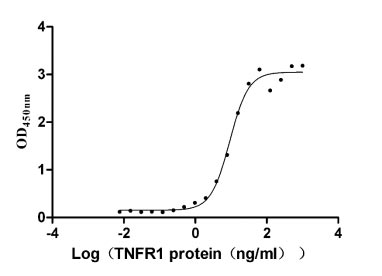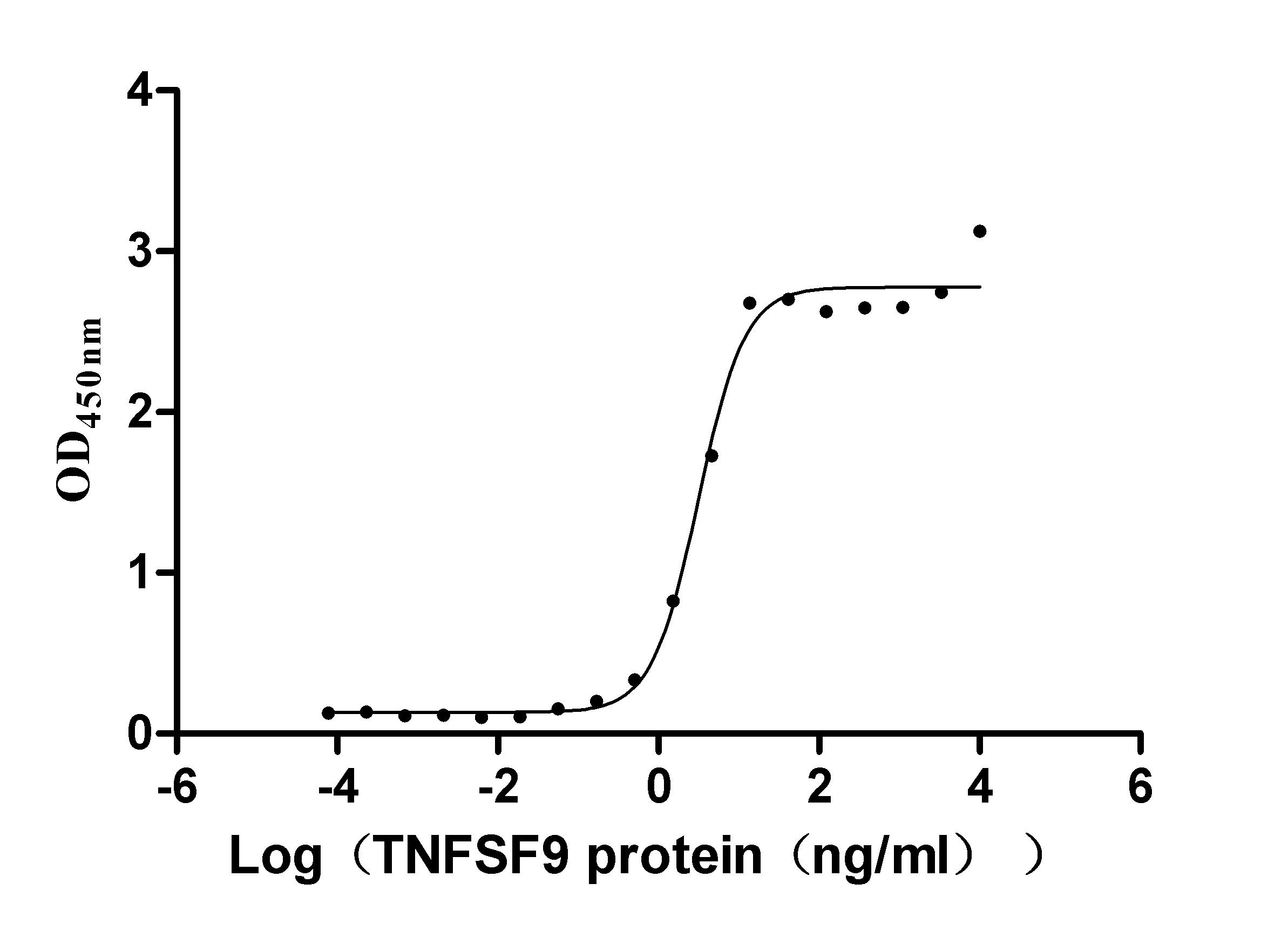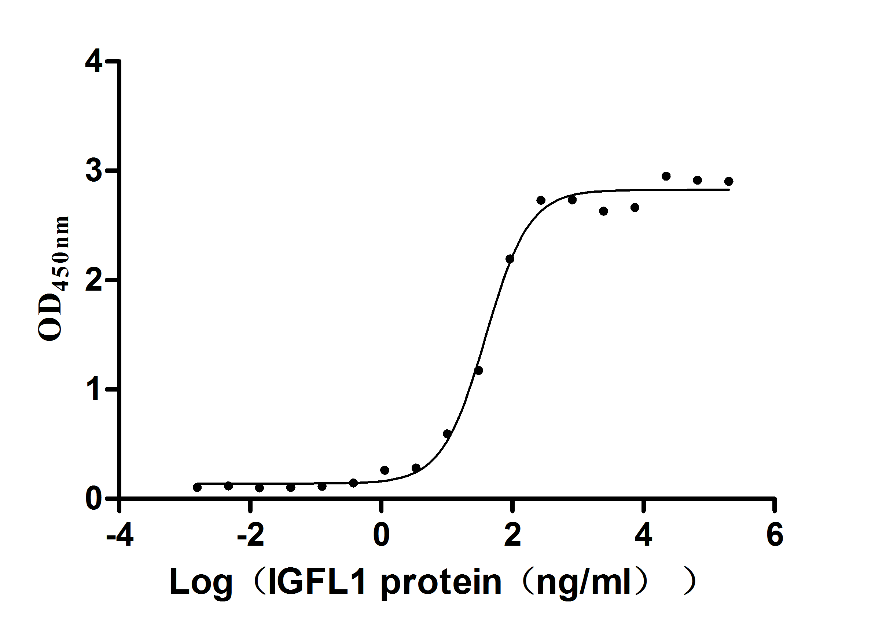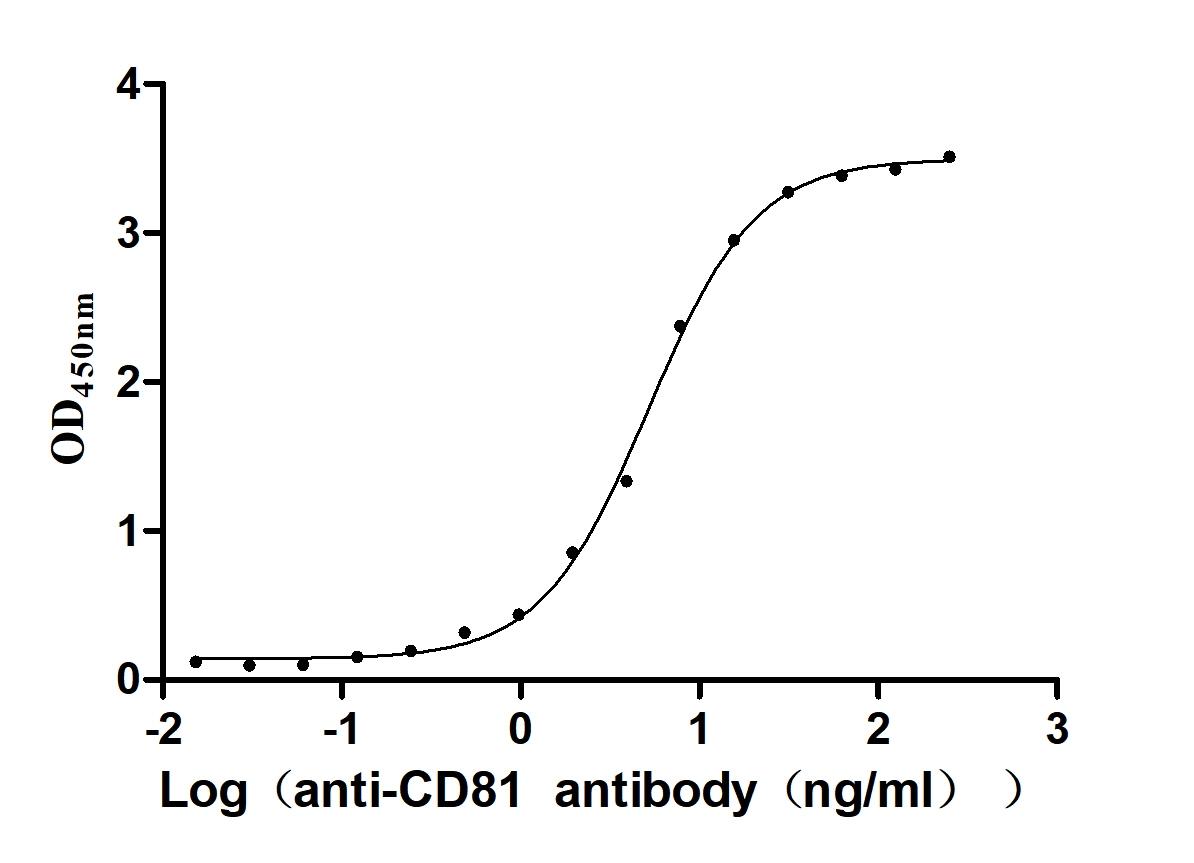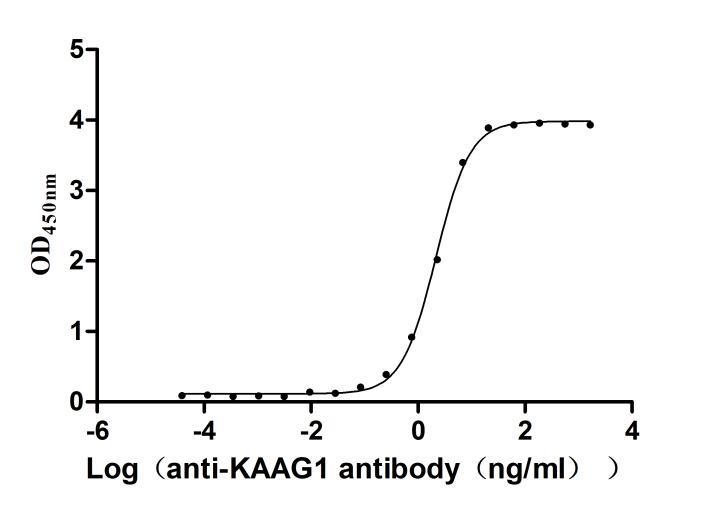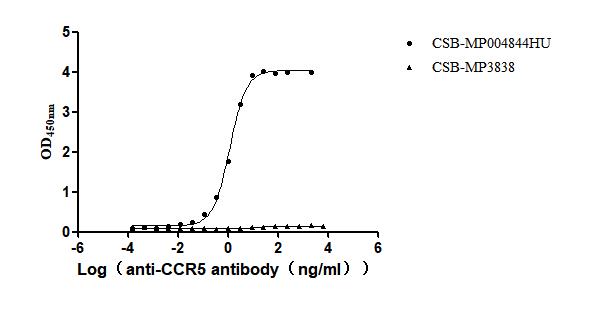Recombinant Mouse Synaptotagmin-7 (Syt7), partial
-
中文名稱:小鼠Syt7重組蛋白
-
貨號:CSB-EP865630MO-B
-
說明書:
-
規格:
-
來源:E.coli
-
共軛:Avi-tag Biotinylated
E. coli biotin ligase (BirA) is highly specific in covalently attaching biotin to the 15 amino acid AviTag peptide. This recombinant protein was biotinylated in vivo by AviTag-BirA technology, which method is BriA catalyzes amide linkage between the biotin and the specific lysine of the AviTag.
-
其他:
產品詳情
-
純度:>85% (SDS-PAGE)
-
基因名:Syt7
-
Uniprot No.:
-
別名:Syt7; Synaptotagmin-7; Synaptotagmin VII; SytVII
-
種屬:Mus musculus (Mouse)
-
蛋白長度:Partial
-
蛋白標簽:Tag?type?will?be?determined?during?the?manufacturing?process.
The tag type will be determined during production process. If you have specified tag type, please tell us and we will develop the specified tag preferentially. -
產品提供形式:Lyophilized powder
Note: We will preferentially ship the format that we have in stock, however, if you have any special requirement for the format, please remark your requirement when placing the order, we will prepare according to your demand. -
復溶:We recommend that this vial be briefly centrifuged prior to opening to bring the contents to the bottom. Please reconstitute protein in deionized sterile water to a concentration of 0.1-1.0 mg/mL.We recommend to add 5-50% of glycerol (final concentration) and aliquot for long-term storage at -20℃/-80℃. Our default final concentration of glycerol is 50%. Customers could use it as reference.
-
儲存條件:Store at -20°C/-80°C upon receipt, aliquoting is necessary for mutiple use. Avoid repeated freeze-thaw cycles.
-
保質期:The shelf life is related to many factors, storage state, buffer ingredients, storage temperature and the stability of the protein itself.
Generally, the shelf life of liquid form is 6 months at -20°C/-80°C. The shelf life of lyophilized form is 12 months at -20°C/-80°C. -
貨期:Delivery time may differ from different purchasing way or location, please kindly consult your local distributors for specific delivery time.Note: All of our proteins are default shipped with normal blue ice packs, if you request to ship with dry ice, please communicate with us in advance and extra fees will be charged.
-
注意事項:Repeated freezing and thawing is not recommended. Store working aliquots at 4°C for up to one week.
-
Datasheet :Please contact us to get it.
靶點詳情
-
功能:Ca(2+) sensor involved in Ca(2+)-dependent exocytosis of secretory and synaptic vesicles through Ca(2+) and phospholipid binding to the C2 domain. Ca(2+) induces binding of the C2-domains to phospholipid membranes and to assembled SNARE-complexes; both actions contribute to triggering exocytosis. SYT7 binds Ca(2+) with high affinity and slow kinetics compared to other synaptotagmins. Involved in Ca(2+)-triggered lysosomal exocytosis, a major component of the plasma membrane repair. Ca(2+)-regulated delivery of lysosomal membranes to the cell surface is also involved in the phagocytic uptake of particles by macrophages. Ca(2+)-triggered lysosomal exocytosis also plays a role in bone remodeling by regulating secretory pathways in osteoclasts and osteoblasts. Involved in cholesterol transport from lysosome to peroxisome by promoting membrane contacts between lysosomes and peroxisomes: probably acts by promoting vesicle fusion by binding phosphatidylinositol-4,5-bisphosphate on peroxisomal membranes. Acts as a key mediator of synaptic facilitation, a process also named short-term synaptic potentiation: synaptic facilitation takes place at synapses with a low initial release probability and is caused by influx of Ca(2+) into the axon terminal after spike generation, increasing the release probability of neurotransmitters. Probably mediates synaptic facilitation by directly increasing the probability of release. May also contribute to synaptic facilitation by regulating synaptic vesicle replenishment, a process required to ensure that synaptic vesicles are ready for the arrival of the next action potential: SYT7 is required for synaptic vesicle replenishment by acting as a sensor for Ca(2+) and by forming a complex with calmodulin. Also acts as a regulator of Ca(2+)-dependent insulin and glucagon secretion in beta-cells. Triggers exocytosis by promoting fusion pore opening and fusion pore expansion in chromaffin cells. Also regulates the secretion of some non-synaptic secretory granules of specialized cells.
-
基因功能參考文獻:
- identify a distinct function of Syt7 ensuring the efficiency of high-frequency inhibitory synaptic transmission PMID: 29166601
- data demonstrate the previously unrecognized observation that PLXNC1 deficiency permits Syt7-mediated macrophage migration and enhances mammalian lung fibrosis PMID: 27609773
- At the calyx synapse that syt7-dependent asynchronous release indeed does not produce a prolonged synaptic signal after a stimulus train and does not contribute to short-term plasticity, but induces a steady-state, asynchronous postsynaptic current during stimulus trains. This steady-state postsynaptic current sustains reliable generation of postsynaptic spikes that are precisely time locked to presynaptic spikes. PMID: 28521135
- synaptotagmin 7 (Syt7) is a calcium sensor that is required for facilitation at several central synapses PMID: 26738595
- Complex of syt 7 and calmodulin serves as a key regulator of synaptic vesicle replenishment in presynaptic nerve terminals. PMID: 24569478
- synaptotagmin-7 is directly activated by GLP-1 signaling and may serve as a drug target for boosting insulin secretion. PMID: 26216970
- knock-out of synaptotagmin-7 selectively impaired delayed asynchronous neurotransmitter release but not synchronous release. In contrast, the readily releasable vesicles after depletion recover normally in knock-out mice. PMID: 26245964
- Results demonstrate that synaptotagmin-7 functions as a positive regulator of GLP-1 secretion in intestinal L-cells and GLUTag cells, consistent with its proposed role as a calcium sensor in GLP-1 secretion. PMID: 21424898
- In synaptotagmin-7 KO mice defective insulin secretion and reduced insulin sensitivity were not sufficient to cause hyperglycaemia in the absence of enhanced glucagon secretion PMID: 20978738
- Mutations in Syt VII palmitoylation sites block trafficking of Syt VII, but not CD63, to lysosomes and phagosomes, whereas tyrosine replacement in the lysosomal targeting motif of CD63 causes both proteins to accumulate on the plasma membrane. PMID: 21041449
- synaptotagmin-7 controls fusion pore dynamics during exocytosis via a push-and-pull mechanism PMID: 20956309
- identified the conserved alternative splicing events in the spacer domain of Syt VII; also shown that Syt VIIa-GFP is mainly localized in the perinuclear region and tips of neurites (dense-core vesicles), and not in the plasma membrane PMID: 12071850
- the lysosomal synaptotagmin Syt VII is required for a mechanism that promotes phagolysosomal fusion and limits the intracellular growth of pathogenic bacteria PMID: 15178804
- Syt VII does not function as the calcium-dependent trigger for lysosomal exocytosis, but instead, restricts the kinetics and extent of calcium-dependent lysosomal fusion PMID: 15226824
- Syt VII regulates the Ca2+-dependent mobilization of lysosomes as a supplemental source of membrane during phagocytosis. PMID: 16982801
- Syt VII regulates perforin-mediated cytolytic CTL responses. PMID: 17237398
- These results show that Ca(2+) binding to the synaptotagmin-7 C(2) domains is physiologically important for stabilizing synaptotagmin-7 and that Ca(2+) binding by synaptotagmin-7 likely does not regulate synaptic vesicle exocytosis. PMID: 18308933
- These findings show that synaptotagmin-7 functions as a positive regulator of insulin secretion and may serve as a calcium sensor controlling insulin secretion in pancreatic beta cells. PMID: 18308938
- Syt7 regulates bone remodeling by modulating osteoclast and osteoblast secretion. PMID: 18539119
- Synaptotagmin-7 is a principal Ca(2+) sensor for glucagon secretion by pancreatic alpha cells. PMID: 19171650
顯示更多
收起更多
-
亞細胞定位:Cell membrane; Single-pass membrane protein. Cell junction, synapse, presynaptic cell membrane; Single-pass membrane protein. Cytoplasmic vesicle, secretory vesicle, synaptic vesicle membrane; Single-pass membrane protein. Lysosome membrane; Single-pass membrane protein. Cytoplasmic vesicle, phagosome membrane; Single-pass membrane protein. Peroxisome membrane; Single-pass membrane protein. Cytoplasmic vesicle, secretory vesicle membrane; Single-pass membrane protein.
-
蛋白家族:Synaptotagmin family
-
組織特異性:Widely expressed. Expressed in insulin-secreting cells. Present in glucagon-secreting cells (at protein level).
-
數據庫鏈接:
Most popular with customers
-
Recombinant Human Tumor necrosis factor receptor superfamily member 1A (TNFRSF1A), partial (Active)
Express system: Mammalian cell
Species: Homo sapiens (Human)
-
Recombinant Human Tumor necrosis factor ligand superfamily member 9 (TNFSF9), partial (Active)
Express system: Mammalian cell
Species: Homo sapiens (Human)
-
Recombinant Human IGF-like family receptor 1 (IGFLR1), partial (Active)
Express system: Mammalian cell
Species: Homo sapiens (Human)
-
Recombinant Human CD81 antigen (CD81), partial (Active)
Express system: Mammalian cell
Species: Homo sapiens (Human)
-
Recombinant Human Kidney-associated antigen 1 (KAAG1) (Active)
Express system: E.coli
Species: Homo sapiens (Human)
-
Recombinant Human C-C chemokine receptor type 5 (CCR5)-VLPs (Active)
Express system: Mammalian cell
Species: Homo sapiens (Human)


